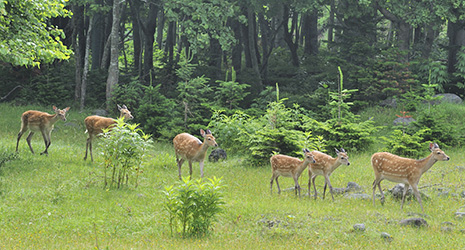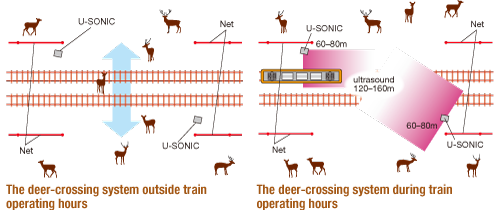April 2020
Level Crossings for Deer

The introduction of a level crossing system for deer has greatly reduced the number of collision accidents involving the animals.
Accidents involving deer are posing a problem for railway services in Japan. As the deer population has increased due to the declining human population in mountain villages including the number of hunters, deer have started to encroach on areas where people live. In response, Kintetsu Railway Co., headquartered in Osaka City and with just over 500 kilometers of service routes covering Osaka, Nara, Kyoto, Mie and Aichi Prefectures, has introduced a Level Crossing System Preventing Deer Collision Accidents. The company aims to enhance the safety of railway services without completely stopping deer from crossing the tracks.
Many accidents involving deer had been occurring in the mountainous areas of the Kintentsu lines, with the number climbing to a peak of 288 in 2015. These accidents forced the company to suspend services for long hours to deal with carcasses and ensure safety. And with the Ise-Shima Summit expected to draw many visitors to the area in 2016, the question of how to decrease the number of deer collision accidents had become a pressing issue.

“Prior to then, we had been taking a variety of measures, such as roping off railways, shining red LED lights to disturb the deer, and installing deer whistles on the trains. These measures produced some results, but were not so effective that they reduced the number of deer crashes to zero,” says a Kintetsu Railway Co. engineer in the Nagoya Transportation Department at Railway Headquarters.
To this end, the company carried out a trial aimed at preventing deer collisions for three months starting in the autumn of 2015 in cooperation with Moharatechnica Co., the manufacturer of U-SONIC, an ultrasound-generating device that scares deer, and Kyosan Electric Mfg. Co., a maker of traffic infrastructure equipment. It was then that an employee of Kintetsu came up with an idea.
Images taken by surveillance cameras installed alongside the railways during the trial showed that deer traveled regularly along the same paths and were active only at dusk and dawn. It was also found that deer came out to lick the rails to supplement the iron lacking in their diet. The trial brought to light the difficulty of entirely stopping deer from crossing the lines since the railroads cut through their natural habitat. The Kintetsu employee applied some reverse logic and suggested the idea of letting deer cross the railways safely instead of shutting them out altogether.
The new system was first installed on the Kintetsu Osaka Line close to Higashi-Aoyama Station in May 2016. Kintetsu installed high netting along the line, but left several ten-meter gaps in a number of sections close to the deer trails. The gaps allow deer to pass freely during the safe hours from the last train until the first train. To prevent deer from crossing the line during the evening hours when they are active and the trains are still running, Kintetsu activated the aforementioned U-SONIC devices from sunset until last train and from the first train until the sun has fully risen.
“There had been seventeen collisions involving deer around Higashi-Aoyama the previous year, but the number has declined to almost zero since the level crossing system was installed. Subsequently, we installed the system in other accident-prone areas. We are confident that the system has achieved a positive effect,” says the Kintetsu engineer.
The application of the same logic of conventional level crossings to the movement of animals along their trails has been highly evaluated and received the Good Design Award in 2017 from the Japan Institute of Design Promotion. With the system now garnering attention from other railway service operators as well, the deer level crossings, which were created in consideration of how deer behave, is expected to contribute significantly to our co-existence with the creatures.


